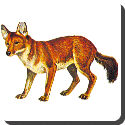 Dhole — The Dhole (Cuon alpinus) is a species of wild dog of the Canidae family. It is also known as the Asiatic Wild Dog; lesser known names also include the Indian Wild Dog, the Red Dog, the Asiatic Dog, and the Whistling Hunter (due to the whistling sound it can make).
Dhole — The Dhole (Cuon alpinus) is a species of wild dog of the Canidae family. It is also known as the Asiatic Wild Dog; lesser known names also include the Indian Wild Dog, the Red Dog, the Asiatic Dog, and the Whistling Hunter (due to the whistling sound it can make).
Within the canid family, the dhole is placed in a genus of its own, which is post-Pleistocene in origin. The dhole has been a distinct species for several thousand years. Cuon means dog in Greek, and alpinus means alpine (Mountain) in Latin. Thus the dhole’s scientific name means mountain dog. The animal is closely related to the genus Canis, and is by some authors considered part of Canis. Other related genera are Lycaon (African wild dog) and, more distantly, Pseudalopex and other South American Foxes.
The dhole is, generally, most active in the early morning and evening, and sometimes at night.
Three geographical races are believed to exist: peninsular, Himalayan and trans-Himalayan.
The dhole exploits a large variety of habitats, reflecting its adaptability. It normally inhabits dry and moist deciduous forests and thick jungles, as well as tropical rain forests, which all provide better cover for hunting. It inhabits areas of primary, secondary, degraded, evergreen, and semi-evergreen forms of vegetation, and dry thorn forests, as well as scrub-forest mosaics. It can also, however, survive in dense alpine forests, meadows and on the open steppes of Kashmir and Manchuria. As the second part of its Latin name, Alpinus, suggests, the dhole is often found in hilly or mountainous regions. Dholes like open spaces and during the day they can often be found on jungle roads and paths, river beds, and in jungle clearings. The dhole inhabits in the widest range of climates in the canid family – from freezing cold to tropical heat, but is not recorded in deserts.
Factors which influence habitat include water, the presence of other large predators (competition), sufficient prey (plentiful medium to large ungulate prey species), local human population, and suitable breeding sites.
The dhole is an omnivore. Its prey are usually deer (like spotted deer, chital, and sambar, the latter of which is over twenty times a dhole’s weight), but also wild boar, red muntjac deer, wild goats, wild sheep, nilgai, mountain sheep, water buffalo calves, hares (like the Black-naped Hare), caribou, reindeer, and sometimes monkeys. On occasion, it will try for large creatures like the banteng, a large bovid. Dholes prefer prey between 31kg and 175kg in weight. Also, the dhole may consume wild berries, insects, rodents, East Asian porcupine, and lizards. In India, the dhole’s favorite prey animal is the medium-sized axis deer. Occasionally they consume grasses and other plants, though this may serve an anti-helminthic function rather than a nutritional one. They are said to feed on the fallen fruit of black wood and bael trees.
 Kids Portal For Parents India Kids Network
Kids Portal For Parents India Kids Network






